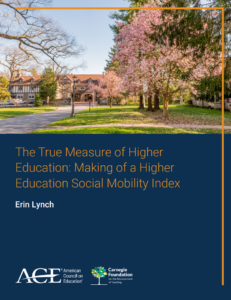Carnegie Classifications White Paper Series
The Carnegie Foundation for the Advancement of Teaching and the American Council on Education partnered in February 2022 to reimagine the future of the Carnegie Classifications. As part of this collaboration, we have explored several topics related to the classifications and their uses as well as key concepts for U.S. higher education, particularly related to social and economic mobility.
Many of those areas of exploration are reflected in this white paper series. Through this page, we aim to contribute to the body of knowledge and research about higher education classification theories and methods; explore specific design decisions in updating current or future classification methodologies; and/or record key areas of discussion from Technical Review Panel meetings. In all cases, the content of these papers serves an advisory function to Carnegie Classifications project staff. Although project staff collaborated with the paper authors in selecting the paper topics, the tremendous insights contained in these papers reflect the knowledge, experiences, and perspectives of the authors themselves. We express our gratitude to them for sharing these insights with the project and the higher education community.
We will publish papers and other classification scholarship on this website, with papers being released over time as they are prepared. Initial white papers assess the impact of the existing Basic Classification methodology, lay some of the groundwork for the upcoming Social and Economic Mobility Classification, and explore technical data-related issues.
Summary of White Paper Topics and Analyses
The following provides a brief overview of the papers that have been published as of May 2024.
The first paper focuses on fundamental issues of creating and implementing organizational classifications. Whitman provides an overview of the theories, approaches, and analytical methods currently available for forming classifications, particularly in the context of higher education. He finds that there are wide range of ways to create classifications and that it is important to be intentional and transparent with the design choices since no approach or method is inherently superior to the others.
A group of papers begin to lay the conceptual and methodological groundwork for the upcoming Social and Economic Mobility Classification. Mabel and Carnevale review the strengths and weaknesses of three notable recent efforts that measure the economic mobility of colleges and universities in the United States. They find there are a diversity of methods in measuring economic mobility, ranging from pure “mobility” approaches that consider income of adults relative to the incomes of their parents to “value” approaches that consider higher education as an investment. Lynch engages the complex and shifting concept of social mobility. She finds that both the definition and the consideration of social mobility in higher education are strongly related to normative values on function and role of education that have evolved over two millennia of human progress.
Baum furthers the analysis of social and economic mobility in higher education by using data from the U.S. Census Bureau and other sources to detail the complex relationships between family income/Pell grant status of students, race/ethnicity, institutional selectivity, postsecondary enrollment, and subsequent labor market outcomes. Her analysis provides the project with a strong rationale to develop adjustments for school-level mobility measures that remove distortions created by the labor market and other factors.
A pair of papers critically engage the existing design of the Basic Classification of the Carnegie Classification through the perspective of minority-serving institutions. Commodore focuses on the relationship between Historically Black Colleges and Universities and the Carnegie Classification. She uses a unique interview dataset of administrators and faculty at HBCUs to explore how the existing Basic Classification methodology, particularly the Research Activity Index, has affected institutional development and organizational behaviors at these critical organizations. Zerquera, Baker, and Youngbull explore how tribal colleges and universities (TCUs) would be classified in the current methodology of the Basic Classification if they were not defaulted into a grouping. In so doing, the authors generate insights on how these unique institutions serve students and communities.
They also begin a conversation on how the contributions of the TCUs could inform the analysis of economic and social mobility at institutions throughout higher education. By examining outcomes of highly differentiated institutions that have not received particularly detailed attention in the current or past version of the Basic Classification, these papers speak to weaknesses and blind spots in the classification methodology that future versions of the Basic Classification and Social and Economic Mobility Classification could address.
Orphan analyzes the changing role of geography and regionality in American higher education. She finds that region-servingness has been a feature of American higher education since the mid-nineteenth century but that increasing nationalization and internationalization of student bodies and other organizational activities has been conflated with institutional development and status. Her analysis guides the project to consider the interaction of geography with organizational design/choice as well as social and economic mobility measures.
Finally, Itzkowitz explores the challenges and opportunities presented by analyzing data collected at different levels of analysis within the same project. Given that federal data collection programs define and report data at different levels of analysis, this is a considerable analytical problem. He advances simple and effective techniques for harmonizing different types of variables collected at different levels of analysis.
Enhancing How We Measure Individual Colleges’ Contributions to Economic Mobility
Anthony P. Carnevale and Zachary Mabel
Maintaining the Asterisk: Tribal Colleges and Universities, Their Communities, and the Carnegie Classification System
Desiree D. Zerquera, Twyla Baker, and Natalie Youngbull







